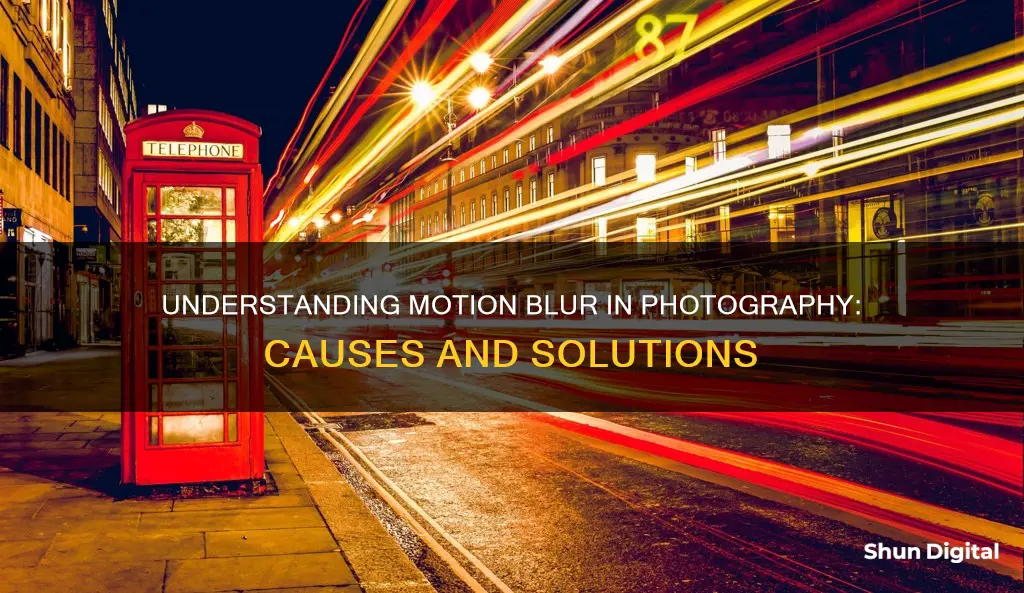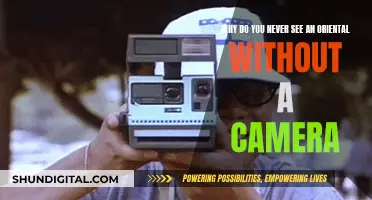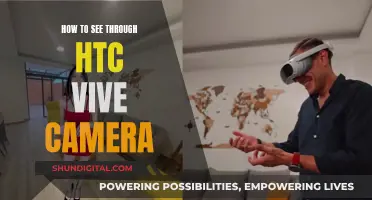
Motion blur is a common issue in photography and filmmaking, occurring when the image being recorded changes during the recording of a single exposure due to rapid movement or long exposure. This results in a streaking or smearing effect, which can be caused by the movement of the camera, the subject, or a combination of the two. While motion blur is often considered undesirable, it can also be used creatively to convey a sense of movement, speed, or peace. Photographers and filmmakers may experiment with different shutter speeds, exposure times, and camera settings to achieve the desired amount of motion blur in their images.
| Characteristics | Values |
|---|---|
| Cause of motion blur | Movement of the camera, the subject, or a combination of the two |
| Effect of motion blur | Streaking or smearing captured on camera |
| Motion blur in film | Occurs naturally in footage shot at standard 24FPS and higher frame rates like 29.97 and 30FPS |
| Human perception of motion blur | Audiences are conditioned to expect a blur in movement in their daily life and on screen |
| Motion blur in animation | Motion blur must be simulated as a virtual camera captures a discrete moment in time |
| Motion blur in video games | Full-screen effects and selective or per-object motion blur |
| Motion blur in sports photography | Conveys a sense of speed |
| Motion blur in aerial mapping/surveying | Occurs when the flight speed is too high or shutter speeds are too long |
| Motion blur in industrial cameras | Caused by movement or vibration during the exposure time |
| Avoiding motion blur | Use a fast shutter speed, a tripod or other camera stabilizer |
What You'll Learn

Motion blur is caused by movement or vibration during exposure
Motion blur is a phenomenon that occurs when there is movement or vibration during the exposure time of the camera. This can be caused by the movement of the camera itself, the movement of the subject being photographed, or a combination of the two. When there is motion during the exposure, the image being recorded changes during a single exposure, resulting in blurring artifacts.
The amount of motion blur is determined by the speed of the moving object and the shutter speed of the camera. A slower shutter speed will result in a longer exposure time, allowing more light to reach the camera sensor and increasing the likelihood of motion blur. Conversely, a faster shutter speed will reduce the exposure time, freezing the scene and reducing the chances of motion blur.
To avoid motion blur, photographers can adjust their camera settings, such as increasing the shutter speed, using a faster ISO setting, or choosing the appropriate aperture for the lighting conditions. Additionally, using a tripod or placing the camera on a stable surface can help minimize camera shake and reduce the chances of motion blur.
In some cases, motion blur is intentionally used as a creative effect to convey a sense of movement or speed in a photograph. This technique is often used in sports photography, automotive photography, and landscape photography to capture motion and add a compelling, creative flair to the image.
The Tiny Dot Pinhole Camera's Intriguing Viewpoint
You may want to see also

Motion blur can be avoided by using a faster shutter speed
Motion blur is a technique in photography that involves using a slow shutter speed to allow moving subjects to blur through the frame. It captures blurred images to convey motion, mimicking how the human eye registers fast movement. While motion blur is often desirable and can provide artistic photos, it can sometimes ruin an otherwise clear image.
Motion blur occurs when the object moves for more than 0.5 pixels during the exposure time. To avoid this, a faster shutter speed can be used to freeze the scene, ensuring the object does not move more than 0.5 pixels during the exposure. This technique is particularly useful for sports photography, where capturing clear images of fast-moving subjects is crucial.
By increasing the shutter speed, you can reduce the blurring effect. A shutter speed of 1/250 second or faster is ideal for capturing fast-moving subjects with minimal or no motion blur. This creates a still image that appears frozen in time, without the blurring effects associated with subject movement.
It is important to note that reducing the exposure time will result in a darker image as there is less time to capture light. To compensate for this, you can use a lens with a larger aperture, such as switching from an F2.0 lens to an F1.4 lens, which allows for the capture of twice as much light. Alternatively, using a camera with larger pixel sizes can increase light sensitivity, as larger pixels can capture more photons.
In summary, motion blur can be avoided by using a faster shutter speed to freeze the action and prevent the object from moving more than 0.5 pixels during the exposure time. This technique is particularly useful for sports and action photography, where capturing clear and sharp images of fast-moving subjects is a priority.
Multi-Camera TV Series: Capturing Multiple Perspectives
You may want to see also

Motion blur can be avoided by reducing exposure time
Motion blur is the streaking or smearing effect captured on camera when either the camera or the subject moves during exposure. This effect can be manipulated to achieve a desired aesthetic, but if you are looking to avoid motion blur, you can do so by reducing the exposure time of the camera.
Reducing the exposure time will limit the amount of light that reaches the camera's sensor, resulting in a darker image. To compensate for this, you can use a lens with a larger aperture, such as an F1.4 lens, which captures twice as much light as an F2.0 lens. However, it is important to note that increasing the aperture will also reduce the camera's depth of field. Alternatively, you can use a camera with larger pixels, as larger pixels can capture more photons, resulting in a brighter image.
Another way to reduce motion blur is to use a faster shutter speed. The shutter speed controls the duration of the exposure, so a faster shutter speed will limit the amount of movement captured during the exposure, resulting in a sharper image. However, if you are photographing a moving subject, you may need to increase the ISO or add external lights to ensure your image is properly exposed.
By reducing the exposure time, either through decreasing the aperture or increasing the shutter speed, you can effectively freeze the scene and avoid motion blur in your photographs.
Hacking CC TV Cameras: A Step-by-Step Guide
You may want to see also

Motion blur can be avoided by using a tripod
Motion blur is the streaking or smearing effect in a photograph caused by the movement of the camera, the subject, or a combination of the two. This effect can be avoided by using a tripod to stabilise the camera.
When using a tripod, it is important to turn off the Image Stabilisation (IS) setting on your camera or lens. IS works by detecting and minimising the error between the desired and actual positions of the camera. However, when the camera is stationary on a tripod, IS may misinterpret system noise as movement, leading to unintended motion. Therefore, turning off IS is crucial to prevent unexpected camera shake.
Additionally, choosing an appropriate shutter speed is essential to avoiding motion blur. A slow shutter speed can cause blurring, especially in low-light conditions or when using a narrow aperture. To compensate, increase your ISO setting, which will allow for a faster shutter speed while maintaining proper exposure. Each stop higher in ISO will enable a correspondingly faster shutter speed. For example, increasing your ISO from 100 to 400 will let you increase your shutter speed from 1/30th of a second to 1/125th of a second, reducing the likelihood of motion blur.
It is also worth noting that some modern cameras, such as certain Olympus models, feature advanced image stabilisation technology. These cameras can effectively compensate for slower shutter speeds, allowing you to capture sharp images even in challenging lighting conditions.
Furthermore, the type of tripod you use can impact your results. Travel tripods, which are lightweight and compact, are ideal for smaller, lighter cameras. However, they may not provide sufficient stability for heavier full-frame camera bodies with large lenses. In such cases, a larger, sturdier tripod is recommended. Additionally, unique tripods like the Benbo 1 offer greater flexibility with a universal joint that allows you to position the legs anywhere, making them useful for confined spaces.
In conclusion, while motion blur can be a frustrating issue, it can be effectively avoided by using a tripod and implementing the appropriate camera settings. By stabilising your camera, choosing the right shutter speed, and utilising modern camera features, you can capture sharp, blur-free images.
Q-See Cameras: Compatible with Other DVR Systems?
You may want to see also

Motion blur can be used creatively to enhance a photograph
Motion blur is the streaking or smearing effect captured on camera due to the movement of the camera or the subject. While it is often considered undesirable, motion blur can be used creatively to enhance a photograph.
Photographers can use motion blur to tell a story or elicit an emotional response from viewers. For example, it can be used to convey a sense of speed or movement, such as in sports or automotive photography, where it can add a dynamic element to the image. It can also be used to capture the abstract look of people crossing a busy intersection or to create a silky softness when photographing waterfalls or the ocean.
To achieve motion blur, photographers can experiment with different shutter speeds, aperture settings, and ISO values. Slowing down the shutter speed is key to creating motion blur, as it allows more light to reach the camera sensor and captures more visual information, including the blur of motion. A longer exposure time can also help achieve this effect. However, photographers must balance their settings to avoid overexposure, especially in well-lit environments.
In addition to adjusting shutter speed, photographers can also use techniques such as panning to keep the moving subject in focus while blurring the background, adding a sense of speed and movement to the image.
When used intentionally and with careful control, motion blur can bring a photograph to life, offering a unique perspective on reality and allowing photographers to express their creative vision.
The Camera's Truth: Unfiltered Reality
You may want to see also
Frequently asked questions
Motion blur is the visual streaking or smearing captured on camera as a result of movement of the camera, the subject, or a combination of the two.
Motion blur is the streaking effect you see in an image that is the result of movement.
The shutter speed affects how much light reaches the camera sensor. A slow shutter speed allows more light to enter the camera, creating motion blur.
To control motion blur, you can adjust the shutter speed, exposure, and motion of the camera and/or subject.
Motion blur can be used creatively to convey a sense of movement, speed, or peace. It can add drama, dynamism, or a passage of time to your photographs.







